Lockheed Martin Corporation is an American aerospace, arms, defense, security, and advanced technologies company with worldwide interests. It was formed by the merger of Lockheed Corporation with Martin Marietta in March 1995. It is headquartered in North Bethesda, Maryland, in the Washington, D.C., area. Lockheed Martin employs approximately 110,000 people worldwide as of January 2020.

STS-38 was a Space Shuttle mission by NASA using the Space Shuttle Atlantis. It was the 37th shuttle mission, and carried a classified payload for the U.S. Department of Defense. It was the 7th flight for Atlantis and the 7th flight dedicated to the Department of Defense. The mission was a 4-day mission that traveled more than 2 million miles and completed 79 revolutions. Atlantis landed at Kennedy Space Center's Shuttle Landing Facility's runway 33. The launch was originally scheduled for July 1990, but was rescheduled due to a hydrogen leak found on Space ShuttleColumbia during the STS-35 countdown. During a rollback to the Orbiter Processing Facility Atlantis was damaged during a hail storm. The eventual launch date of 15 November 1990 was set due to a payload problem. The launch window was between 18:30 and 22:30 EST. The launch occurred at 18:48 EST.
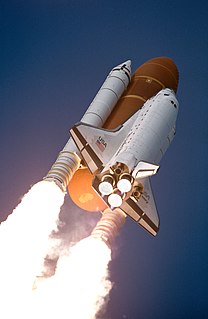
STS-53 was a Space Shuttle Discovery mission in support of the United States Department of Defense. The mission was launched on 2 December 1992 from Kennedy Space Center, Florida.
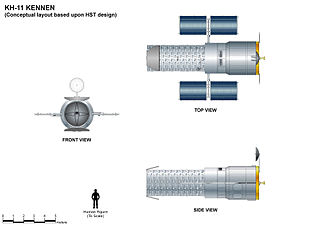
The KH-11 KENNEN is a type of reconnaissance satellite first launched by the American National Reconnaissance Office in December 1976. Manufactured by Lockheed in Sunnyvale, California, the KH-11 was the first American spy satellite to use electro-optical digital imaging, and so offer real-time optical observations.

The Defense Meteorological Satellite Program (DMSP) monitors meteorological, oceanographic, and solar-terrestrial physics for the United States Department of Defense. The program is managed by the United States Space Force with on-orbit operations provided by the National Oceanic and Atmospheric Administration (NOAA). The mission of the satellites was revealed in March 1973. They provide cloud cover imagery from polar orbits that are Sun-synchronous at nominal altitude of 830 km (520 mi).

A military satellite is an artificial satellite used for a military purpose. The most common missions are intelligence gathering, navigation and military communications.
Orbital Sciences Corporation was an American company specializing in the design, manufacture and launch of small- and medium- class space and rocket systems for commercial, military and other government customers. In 2014 Orbital merged with Alliant Techsystems to create a new company called Orbital ATK, Inc., which in turn was purchased by Northrop Grumman in 2018. The remnants of the former Orbital Sciences Corporation today are a subsidiary of Northrop Grumman known as Northrop Grumman Space Systems.

The Space-Based Infrared System (SBIRS) is a United States Space Force system intended to meet the United States' infrared space surveillance needs through the first two to three decades of the 21st century. The SBIRS program is designed to provide key capabilities in the areas of missile warning, missile defense and battlespace characterization via satellites in geosynchronous Earth orbit (GEO), sensors hosted on satellites in highly elliptical orbit (HEO), and ground-based data processing and control.
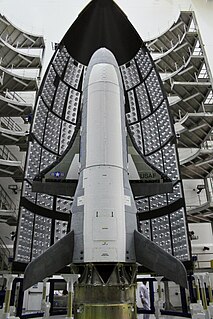
The Boeing X-37, also known as the Orbital Test Vehicle (OTV), is a reusable robotic spacecraft. It is boosted into space by a launch vehicle, then re-enters Earth's atmosphere and lands as a spaceplane. The X-37 is operated by the United States Space Force, and was previously operated by Air Force Space Command until 2019 for orbital spaceflight missions intended to demonstrate reusable space technologies. It is a 120-percent-scaled derivative of the earlier Boeing X-40. The X-37 began as a NASA project in 1999, before being transferred to the United States Department of Defense in 2004.
Lockheed Martin Space is one of the four major business divisions of Lockheed Martin. It has its headquarters in Denver, Colorado with additional sites in Sunnyvale, California; Santa Cruz, California; Huntsville, Alabama; and elsewhere in the United States and United Kingdom. The division currently employs about 16,000 people, and its most notable products are commercial and military satellites, space probes, missile defense systems, NASA's Orion spacecraft, and the Space Shuttle external tank.
The Aerospace Corporation is an American California nonprofit corporation that operates a federally funded research and development center (FFRDC) headquartered in El Segundo, California. The corporation provides technical guidance and advice on all aspects of space missions to military, civil, and commercial customers. As the FFRDC for national-security space, Aerospace works closely with organizations such as the United States Air Force Space and Missile Systems Center (SMC) and the National Reconnaissance Office (NRO) to provide "objective technical analyses and assessments for space programs that serve the national interest". Although SMC and NRO are the primary customers, Aerospace also performs work for civil agencies as well as international organizations and governments in the national interest.

Space Launch Complex 3 (SLC-3) is a launch site at Vandenberg Air Force Base that consists of two separate launch pads. SLC-3E (East) is currently used by the Atlas V launch vehicle, while SLC-3W (West) has been demolished.
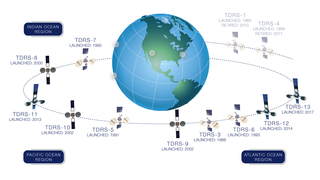
A tracking and data relay satellite (TDRS) is a type of communications satellite that forms part of the Tracking and Data Relay Satellite System (TDRSS) used by NASA and other United States government agencies for communications to and from independent "User Platforms" such as satellites, balloons, aircraft, the International Space Station, and remote bases like the Amundsen-Scott South Pole Station. This system was designed to replace an existing worldwide network of ground stations that had supported all of NASA's crewed flight missions and uncrewed satellites in low-Earth orbits. The primary system design goal was to increase the amount of time that these spacecraft were in communication with the ground and improve the amount of data that could be transferred. These TDRSS satellites are all designed and built to be launched to and function in geosynchronous orbit, 35,786 km (22,236 mi) above the surface of the Earth.

The Defense Satellite Communications System (DSCS) is a United States Space Force satellite constellation that provides the United States with military communications to support globally distributed military users. Beginning in 2007, DSCS is being replaced by the Wideband Global SATCOM system. A total of 14 DSCS-III satellites were launched between the early 1980s and 2003. Two satellites were launched aboard the Space Shuttle Atlantis in 1985 during the STS-51-J flight. As of 23 November 2015, seven DSCS-III satellites were still operational. DSCS operations are currently run by the 4th Space Operations Squadron out of Schriever Air Force Base.
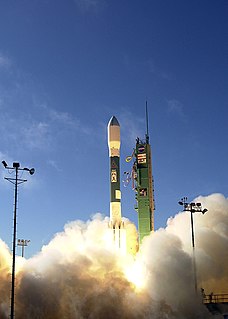
USA-193, also known as NRO Launch 21, was a U.S. military reconnaissance satellite launched on 14 December 2006. It was the first launch conducted by the United Launch Alliance (ULA). Owned by the National Reconnaissance Office (NRO), the craft's precise function and purpose were classified.
The United States Missile Defense Agency (MDA) has developed a Space Tracking and Surveillance System (STSS) which was used to research the space-based detection and tracking of ballistic missiles. Data from STSS satellites could allow interceptors to engage incoming missiles earlier in flight than would be possible with other missile detection systems. The STSS program began in 2001, when the "SBIRS Low" program was transferred to MDA from the United States Air Force. In December 2002, SBIRS Low Research & Development was renamed Space Tracking and Surveillance System (STSS).

The space policy of the United States includes both the making of space policy through the legislative process, and the implementation of that policy in the civilian and military US space programs through regulatory agencies. The early history of United States space policy is linked to the US–Soviet Space Race of the 1960s, which gave way to the Space Shuttle program. There is a current debate on the post-Space Shuttle future of the civilian space program.

The Joint Polar Satellite System (JPSS) is the latest generation of U.S. polar-orbiting, non-geosynchronous, environmental satellites. JPSS will provide the global environmental data used in numerical weather prediction models for forecasts, and scientific data used for climate monitoring. JPSS will aid in fulfilling the mission of the U.S. National Oceanic and Atmospheric Administration (NOAA), an agency of the Department of Commerce. Data and imagery obtained from the JPSS will increase timeliness and accuracy of public warnings and forecasts of climate and weather events, thus reducing the potential loss of human life and property and advancing the national economy. The JPSS is developed by the National Aeronautics and Space Administration (NASA) for the National Oceanic and Atmospheric Administration (NOAA), who is responsible for operation of JPSS. Three to five satellites are planned for the JPSS constellation of satellites. JPSS satellites will be flown, and the scientific data from JPSS will be processed, by the JPSS – Common Ground System (JPSS-CGS).

While the United States Space Force gained its independence on 20 December 2019, the history of the United States Space Force can be traced back to the beginnings of the military space program following the conclusion of the Second World War in 1945. Early military space development was begun within the United States Army Air Forces by General Henry H. Arnold, who identified space as a crucial military arena decades before the first spaceflight. Gaining its independence from the Army on 18 September 1947, the United States Air Force began development of military space and ballistic missile programs, while also competing with the United States Army and United States Navy for the space mission.
USA-197, also known as DSP-23, is a missile detection satellite and part of the Defense Support Program that was launched in 2007.














